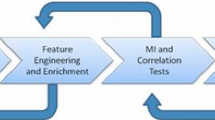Abstract
This paper introduces a framework for fraud detection in mobile communication networks based on the current as well as past behavioral pattern of subscribers. The proposed fraud detection system (FDS) consists of four components, namely, rule-based deviation detector, Dempster-Shafer component, call history database and Bayesian learning. In the rule-based component, we determine the suspicion level of each incoming call based on the extent to which it deviates from expected call patterns. Dempster-Shafer’s theory is used to combine multiple evidences from the rule-based component and an overall suspicion score is computed. A call is classified as normal, abnormal, or suspicious depending on this suspicion score. Once a call from a mobile phone is found to be suspicious, belief is further strengthened or weakened based on the similarity with fraudulent or genuine call history using Bayesian learning. Our experimental results show that the method is very promising in detecting fraudulent behavior without raising too many false alarms.
Preview
Unable to display preview. Download preview PDF.
Similar content being viewed by others
References
Fraud Analytics for Telecom (February 2007), http://www.fairisaac.com/Fairisaac/Solutions/Product+Index/Fraud+Analytics+for+Telecom/
Barson, P., Field, S., Davey, N., McAskie, G., Frank, R.: The Detection of Fraud in Mobile Phone Networks, Neural Network World, pp. 477–484 (1996)
Hoath, P.: Telecoms Fraud, The Gory Details, Computer Fraud & Security, pp. 10–14 (January 1998)
Moreau, Y., Preneel, B., Burge, P., Shawe-Taylor, J., Stoermann, C., Cook, C.: Novel Techniques for Fraud Detection in Mobile Telecommunication Networks. In: ACTS Mobile Summit (1997)
Moreau, Y., Vandewalle, J.: Detection of Mobile Phone Fraud using Supervised Neural Networks: A First Prototype. In: Proceedings of the International Conference on Artificial Neural Networks (1997)
Burge, P., Shawe-Taylor, J.: Detecting Cellular Fraud Using Adaptive Prototypes. In: Proceedings of the Workshop on AI Approaches to Fraud Detection and Risk Management, pp. 9–13 (1997)
Taniguchi, M., Haft, M., Hollmen, J., Tresp, V.: Fraud Detection in Communication Networks using Neural and Probabilistic methods. In: Proceedings of the IEEE International Conference on Acoustics, Speech, and Signal Processing, pp. 1241–1244 (May 1998)
Fawcett, T., Provost, F.: Combining Data Mining and Machine Learning for Effective User Profiling. In: Proceedings of the Conference on Knowledge Discovery and Data Mining (1996)
Murad, U., Pinkas, G.: Unsupervised Profiling for Identifying Superimposed Fraud. In: Proceedings of the 3rd European Conference on Principles of Data Mining and Knowledge Discovery, pp. 251–261 (1999)
Rosset, S., Murad, U., Neumann, E., Idan, Y., Pinkas, G.: Discovery of Fraud Rules for Telecommunications - Challenges and Solutions. In: Proceedings of the Conference on Knowledge Discovery and Data Mining, pp. 409–413 (1999)
Burge, P., Shawe-Taylor, J.: An Unsupervised Neural Network Approach to Profiling the Behavior of Mobile Phone Users for Use in Fraud Detection. Journal of Parallel and Distributed Computing, 915–925 (2001)
Grosser, H., Britos, P., Garcia-Martinez, R.: Detecting Fraud in Mobile Telephony Using Neural Networks. In: Proceedings of the 18th International Conference on Industrial and Engineering Applications of Artificial Intelligence and Expert Systems, pp. 613–615 (2005)
Britos, P., Grosser, H., Sierra, E., Garcia-Martinez, R.: Unusual Changes of Consumption Detection in Mobile Phone Users. Special Issue in Neural Networks and Associative Memories Research in Computing Science, pp. 195–204 (2006)
Kou, Y., Lu, C.T., Sirwonqattana, S., Huanq, Y.P.: Survey of Fraud Detection Techniques. In: Proceedings of the IEEE International Conference on Networking, Sensing and Control, pp. 749–754 (2004)
Bolton, R.J., Hand, D.J.: Statistical Fraud Detection: A Review. Journal of Statistical Science, 235–255 (2002)
Bolton, R.J., Hand, D.J.: Unsupervised Profiling Methods for Fraud Detection. In: Proceedings of the Conference on Credit Scoring and Credit Control (September 2001)
Wang, Y., Yang, H., Wang, X., Zhang, R.: Distributed Intrusion Detection System Based on Data Fusion Method. In: Proceedings of the 5th World Congress on Intelligent Control and Automation, pp. 4331–4334 (June 2004)
Chen, T.M., Venkataramanan, V.: Dempster-Shafer Theory for Intrusion Detection in Ad Hoc Networks. In: Proceedings of the IEEE Internet Computing, pp. 35–41 (December 2005)
Author information
Authors and Affiliations
Editor information
Rights and permissions
Copyright information
© 2007 Springer Berlin Heidelberg
About this paper
Cite this paper
Panigrahi, S., Kundu, A., Sural, S., Majumdar, A.K. (2007). Use of Dempster-Shafer Theory and Bayesian Inferencing for Fraud Detection in Mobile Communication Networks. In: Pieprzyk, J., Ghodosi, H., Dawson, E. (eds) Information Security and Privacy. ACISP 2007. Lecture Notes in Computer Science, vol 4586. Springer, Berlin, Heidelberg. https://doi.org/10.1007/978-3-540-73458-1_32
Download citation
DOI: https://doi.org/10.1007/978-3-540-73458-1_32
Publisher Name: Springer, Berlin, Heidelberg
Print ISBN: 978-3-540-73457-4
Online ISBN: 978-3-540-73458-1
eBook Packages: Computer ScienceComputer Science (R0)




